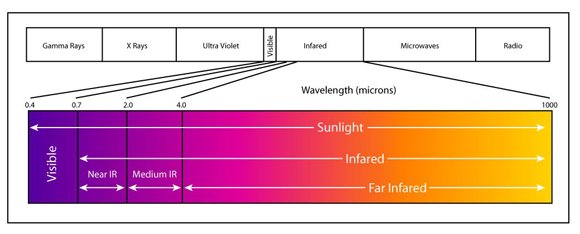Far-Infrared vs. Full-Spectrum Saunas
We now have THREE infrared saunas at Hope Floats, two of which are Far-Infrared, and our newest sauna is Full-Spectrum. We are excited to offer both technologies to the Washington D.C. and DMV communities.
Here, we’ll explain the difference between the two types of infrared saunas, so you can make an informed choice when you make an appointment depending on your wellness goals.
What is an infrared sauna?
For reference, traditional saunas use steam to warm the air, which in turn warms your body.
Infrared light causes your core body temperature to rise without necessarily heating the air around you, providing a gentle, soothing heat.
Infrared saunas are known for being more comfortable and easier to breathe in while providing the same health benefits as traditional saunas.
What does “infrared” mean?
Infrared is a part of the electromagnetic spectrum. It is a form of light that has waves larger than the visible light.
Nearly half of the light the sun emits is infrared light which generates heat.
We’ve been using Infrared technology in saunas since 1893 (back when it was known as an Incandescent Light Bath).
Types of Infrared Light
NASA was the first to discover the difference in types of infrared wavelengths and to use near-infrared light to grow plants.
Without diving too deep into the electromagnetic spectrum, here is a visual graphic that indicates the types of Infrared light we’re talking about when it comes to saunas.
Photo Source: TrueLight
There are three types of infrared light: near, mid, and far. Each has a different wavelength, therefore impacting our bodies in different ways.
The larger the wavelength, the deeper the light penetrates our bodies.
Near-infrared light, with the shortest wavelengths, has the most impact on our skin.
Keep reading to learn all about the benefits of each type of Infrared Light.
Far-Infrared Light
Far-infrared light reaches deep below the skin. It warms the body from the inside out, causing the body to sweat.
Far-infrared heat penetrates tissue, joints, and muscles to relieve anything from minor aches and pains to chronic pain conditions such as fibromyalgia.
Pain management professionals incorporate far-infrared saunas into treatment plans to decrease pain and muscle spasms and to speed up recovery time.
Your body will naturally work to keep itself cool throughout your sauna experience. This takes a lot of energy, burning several hundred calories per session, which boosts the metabolism and promotes the loss of body fat.
As your body sweats, you’ll notice your heart rate pick up. This helps to improve circulation and lower blood pressure, similar to the effect of exercise.
As far as detoxification goes, far-infrared light encourages the body to let go of toxins and heavy metals from deep inside.
Unless advertised as “full-spectrum,” infrared saunas typically only emit far infrared light.
Far-infrared saunas are the most commonly used and researched in today’s scientific and wellness communities.
Full-spectrum Saunas have Far, Mid, and Near Infrared Light
This means that sitting in a full-spectrum sauna will impact your body deeply, the same way a far-infrared sauna would, plus the added benefits of near and mid-infrared light:
Mid-Infrared Light
Mid-infrared light goes just past the skin to focus on the body’s soft tissue. This is where a majority of the blood flows, and is where inflammation commonly resides.
Mid-infrared light helps expand the blood vessels and increase oxygen circulation throughout the skin and soft tissues of the body.
Mid-infrared light has also been shown to reduce joint pain and may even prevent the growth of cancer cells.
Near-Infrared Light
Also known as Red Light Therapy, near-infrared light penetrates the outermost layer of our bodies: the skin.
Today, Red Light Therapy has been used in a variety of ways, including face mask devices, lamps, and spa treatments that target specific areas of the skin.
Why? Red Light Therapy, using Near-Infrared Light, has been proven to positively impact the skin on a molecular level. It reaches the mitochondria (commonly known as the “powerhouse of the cell”) and causes cells to circulate improved levels of oxygen throughout the skin.
Continued use of near-infrared light therapy is effective at:
promoting collagen production,
rejuvenating skin thickness and elasticity,
improving cell health and regeneration,
So, which sauna should you choose?
While both saunas warm the body and benefit overall health and wellness, you may choose a far-infrared or full-spectrum sauna session depending on your specific goals.
For example, if you are interested in noticing the benefits that relate to reducing wrinkles or signs of aging skin, we recommend the full-spectrum sauna.
If you are interested in the benefits related to muscle recovery, pain relief, or heart health, the far infrared sauna will be a good fit.
Or, try both of them to see which infrared experience you prefer.
Benefits of Repeated Sauna Use
You may feel some immediate benefits after your first sauna session, such as relaxation, but long-term benefits require long-term and repeated use of the sauna.
Using the sauna consistently over time can help you live longer.
In the 80s, a study began to determine if using a sauna regularly would result in lower rates of cardiovascular disease. The study followed nearly 2500 middle-aged Finnish men over 20+ years. It found:
Men who used the sauna 2-3 times per week were 27% less likely to die from a cardiovascular event
Men who used the sauna 4-7 times per week were 50% less likely to die from a cardiovascular event.
Men who used the sauna 4-7 times per week were 40% less likely to die from all-cause mortality (cancer, neurodegenerative disease, and respiratory disease).
Sauna bathing is inversely associated with dementias, such as Alzheimer’s disease.
Bring your loved ones to Hope Floats
Our far-infrared saunas each fit up to four adults at a time.
One of our far infrared saunas is located in our private Contrast Therapy room, next to a 45-degree cold plunge bath.


